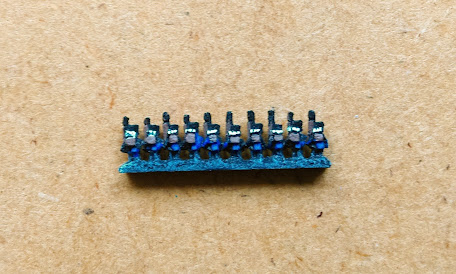I have lumped these together, as the show offs of the French and Austrian armies are surprisingly similar to paint at this scale. I can see some purists already wincing, but in practice the uniforms are similar from a distance.
You can paint both using the same broad colour palette, which is good! Of course, depending on the hussar regiment, the colours may be very different. I happen to be painting the green uniform of the Chasseurs à Cheval and the Austrian 8th Hussar Regiment "Kienmayer", which has a predominantly green uniform. You may be painting other colours, so while I will give you my colours, you should use whichever you are aiming for.
One thing to note - I'd learnt at this point that I needed bright colours, so my choices reflect this.
Chasseurs à Cheval
Start by undercoating black. As with the infantry, this is a good base coat, and it hides any errors well. First is to drybrush the horses. I use Gorthor Brown, but choose your own colour. You will be seeing these from a distance, so I would choose the same colour for all the horses. Don't bother with painting blazes or stockings.
 |
| Drybrushing is your friend - it saves you so much time! |
Next paint the uniform. Chasseurs had green uniforms, rather darker than mine are, but you don't want the models to blend into a dark mass. I use Skarsnik Green, and a very delicate brush. The Army Painter: Super Detail brush is perfect for this. You want to paint the legs, arms and back.
 |
| This is very easy, but looks very impressive. Also, that black undercoat helps define the figures. |
 |
| Single line of paint. Vary the scabbard colours - change them at your pleasure. Gaudy is not bad! |
 |
| I've also added some Rakarth Flesh highlights on the horses' tails. You can also see the saddles a bit better here. |
 |
| I can't emphasise how good drybrushing is. Mine looks very dark here, but you can lighten the colours with ease. |
 |
| Two colours and look how good they already look! |
 |
| Fairly little work, but they look great! |
Overview

































